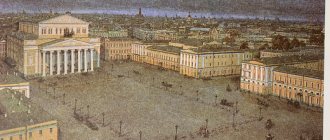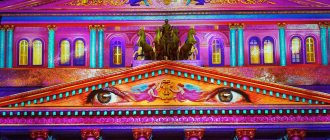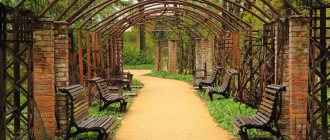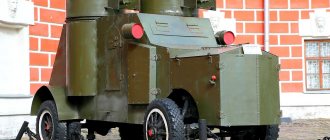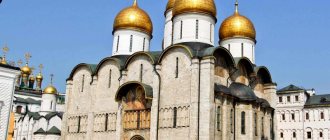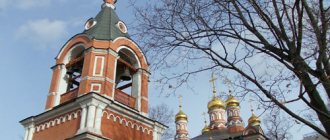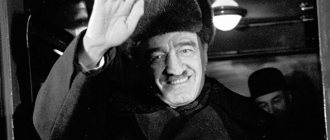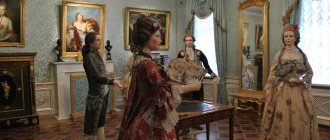The sights of our country keep many mysteries. “History is written by the winners,” a famous politician once said, and this quote is still relevant today. Almost once every few decades, history is adjusted to suit the interests of the powers that be - everyone is already accustomed to this. However, in addition to small insinuations, such as who was right and who was wrong, you can often encounter outright lies and concealment of the most important facts. But there are silent witnesses to what happened on the territory of our country - these are architectural monuments, and only by looking closely at them, you can find answers to many questions. However, most often it’s the other way around: these questions become even more numerous.
One of these “talking” attractions is the State Academic Bolshoi Theater of Russia. This building is located on Teatralnaya Square in the very center of Moscow and, as we can see, is fraught with many mysteries, which we will try to figure out.
- The Bolshoi Theater building is not the first version of the construction.
- Osip Bove is the author of the modern version of the building.
- The Bolshoi Theater building could have been the Temple of Apollo.
- The theater's underground structures are 27 meters deep.
We will try to reveal the secrets of the Bolshoi Theater, carefully hidden from us by the official historical version.
Tickets
You need to buy tickets to the Bolshoi Theater in advance and only on official platforms: the Bolshoi Theater warns that in other places and especially in transactions with private individuals, there is a high probability of paying for a fake.
Prices
Ticket prices to the Bolshoi Theater range from 100 to 15,000 rubles.
Such a wide price range can be explained simply: the cheapest tickets are sold under the special program “Big for Young” (for spectators 16 - 25 years old). Instructions on how to buy a ticket to the Bolshoi Theater for 100 rubles are on the official website.
Ticket prices to the Bolshoi Theater in 2021
Where can I buy
Official sales points:
- Bolshoi Theater box office;
- Theater website - www.bolshoi.ru; separate page - buy tickets online;
- Official distributors: list on the website.
Sample tickets. Detailed description - on the official website of the Bolshoi Theater
Cash desks: operating hours
- In the administrative building of the Bolshoi Theater (address - Bolshaya Dmitrovka St., 2, to the left of the metro exit): daily, from 11:00 to 20:00, there is a break from 15:00 to 16:00; on ticket pre-sale days (Saturdays), the box office opens an hour earlier - from 10:00;
- In the Historical Stage building (entrance No. 12): daily from 11:00 to 20:00, there is a break from 16:00 to 18:00; on the days of matinee performances - from 10:00;
- In the New Stage building: daily from 11:00 to 20:00, break from 14:00 to 15:00; on the days of matinee performances - from 10:00;
- In the GUM building (first line, first floor): daily, from 11:00 to 20:00.
Information on the official website: box office on the map, purchasing tickets
Previous versions of the building
The Bolshoi Theater is one of the largest theaters in Russia. The construction of the building itself dates back to 1856. However, the history of the theater on this site dates back to 1776, when Prince Urusov received permission from Empress Ekaterina Alekseevna to erect a building on this site. The theater burned down under mysterious circumstances even before the official opening. Construction of the new theater began under the leadership of Michael Maddox, an English entrepreneur.
The author of the building was the architect Christian Rosberg, who completed the construction of the theater by 1789. The construction of the rather impressive three-story building took only five months - an astonishing speed of work that would be the envy of many modern builders with their latest technology. Actually, here is a picture of the building itself.
Agree that it is quite difficult to build such a building in the 18th century in five months. And this despite the fact that the theater is being built next to the Neglinka River, more precisely, on the right, low-lying bank, which in the spring turned into a mud mess. Therefore, it is believed that the building was placed on bog oak piles. Given the size of the building, several thousand piles would be needed. And it is hardly possible to do such work in five months.
The very degree of complexity of the construction can be seen in the drawing of a longitudinal section of the building from Maddox’s album. And all this in five months.
After 25 years of successful operation of the theater, the building... burned down again. Before the start of the performance, at four o'clock in the evening, wardrobe master Karl Felker forgot two burning candles in the wardrobe, which caused the fire. Again some kind of dark story. Was there really no lighting in such a majestic building? Yes, the official historical version tells us that the entire building was lit with candles: they hung on the walls, under the ceiling, and so on. This is hard to believe, given the size of the building. To illuminate it, thousands of candles would be required, which would smoke, drip with wax, and would have to be constantly changed. Even if we assume that this is possible, the performance in the theater could last more than three hours; How did they manage to illuminate the building all this time without replacing the candles? Or did they change during the performance?
History and architecture
The Bolshoi Theater was founded by the provincial prosecutor, Prince Pyotr Urusov, who received from Empress Catherine II the privilege of hosting “theatrical performances of all kinds.” The date of the highest permission - March 28, 1776 - is considered the date of foundation of the Bolshoi Theater.
The first theater building opened on the banks of the Neglinnaya River on December 30, 1780, was located on Petrovka Street and was called the Petrovsky Theater. The three-story brick building with white stone elements was erected in a record time for those times - in just 5 months - and at the same time became the largest public theater in Moscow. The hall housed a stall, three tiers of boxes, and a gallery. The number of seats supposedly ranged from 800 to 1000. For the most part, the theater was led by Urusov’s companion, Michael Maddox: under him, over 14 years, 425 opera and ballet performances were staged in the theater.
After the expiration of the personal privilege, the theater with the accumulated debts in 1796 was transferred to the Board of Trustees. In 1805, the building of the Petrovsky Theater burned down, and the troupe was forced to perform on temporary stages. In 1808, according to the design of K. I. Rossi, a new theater was built - Arbatsky, which did not last long - it burned down in the fire of the War of 1812.
The next building of the Petrovsky Theater - according to the design of A. A. Mikhailov, revised by O. I. Bove - was inaugurated on January 6, 1825. The monumental building was significantly larger than its predecessors in size, and therefore the new theater, whose height was 37 meters, was called the Bolshoi Petrovsky. However, the premiere show still had to be repeated: the opened theater could not accommodate everyone. The building was the main theater venue in the capital for almost 30 years: it burned down in March 1853, along with unique theater machines, instruments and all the props.
The project of A.K. Kavos was chosen to restore the Bolshoi Theater. The building was rebuilt in three years, maintaining the same volume and layout. At the same time, the architect changed the proportions, increasing the height of the building, and also redesigned the architectural decor, designing the facades in the spirit of early eclecticism. The columns of the portico have been preserved. Above the portico there is a bronze quadriga by P. K. Klodt. The theater opened its doors on August 20, 1856.
Historical stage, restored hall (photo - 2021), © Andrey and Valeria
The back side of the building was rebuilt in 1886–1893 according to the design of E. K. Gernet, and the columns were hidden in storage rooms.
In 1894–1898, the foundation under the building was replaced, since by that time cracks had appeared along the walls. The forced measure did not stop the shrinkage of the building.
In the 1920s, the semi-circular wall of the auditorium was strengthened, the curtain was replaced and the interior rooms were redesigned. The latest measure was aimed at eliminating the rank hierarchy of viewers.
The famous luxurious brocade curtain adorned the Bolshoi Theater in 1955 and remained the main decoration of the stage for 50 years. Returned in restored form after a large-scale reconstruction of the historical stage in 2005–2011.
Main chandelier of the Bolshoi Theater, © Natalia Konnova
Theater built by Albert Kavos
The theater opened on August 20, 1856. The architect, having rebuilt the building, increased the height of the walls by 2 meters, creating the main facade in large, expressive and laconic forms of classicism.
Architecture and façade features
The building looks solemn: perfect symmetry, an eight-column white stone portico , a sculptural composition by Peter Klodt: a chariot with four harnessed horses galloping across the sky, and Apollo driving them. The only decoration of the main facade is a square rustication and a ribbon of ornamental frieze under the cornice as the embodiment of the theatrical architecture of classicism.
An additional pediment was erected above the main portico, covering the decoration hall. On the pediment was the state emblem of Russia - a plaster double-headed eagle. Sculptural decorations were added to the external decoration, and decorative niches were built in. The walls were covered with rustication, the entrances in front of the entrance were equipped with a ramp for carriages to enter. The facade is painted sand color. The impressiveness of the structure is emphasized by the spacious Theater Square.
Auditorium
Albert Kavos paid great attention to the auditorium, creating it with six tiers for 2,300 spectators. The plan of the hall is similar to a violin, tapering towards the orchestra's location. To create good acoustics in the hall, the architect came up with many unusual solutions: he changed the curvature of the walls and made the ceiling flatter.
The panels were covered with resonant spruce, from which musical instruments are made. The portal arch of the stage was increased to the width of the hall, acoustic cavities were installed, and the orchestra pit was deepened and expanded. The stucco molding is made of papier-mâché, which enhances sound.
The interior of the hall is an elegant combination of the Renaissance and Byzantine style : a combination of white, gold and bright crimson colors. The decoration of the hall is a majestic crystal chandelier created in France especially for the Bolshoi Theater. Around the chandelier there is an elegant painting “Apollo and the Muses”.
In the center of the foyer is the entrance to the imperial box with a double-headed eagle, located opposite the stage. Above the door of the box, which is supported by Atlanteans made of papier-mâché, flaunts the monogram of the last Emperor Nicholas II.
Bolshoi Theater repertoire
Over the years of operation of the Bolshoi Theater, over 800 works have been staged on its stage.
The premiere of the Bolshoi Theater took place in 1777: it was D. Zorin’s opera “Rebirth”. The young theater actively staged operas by Russian and Italian composers, ballet numbers, dance skits on the theme of folk life, as well as musical performances on mythological subjects.
Large-scale operas established themselves in the theater only in the 1840s. Significant events for the theatrical life of Moscow were the operas “A Life for the Tsar” and “Ruslan and Lyudmila” presented to the audience by M. I. Glinka. In the second half of the 19th century, the repertoire expanded with outstanding ballet productions: based on the works of P. I. Tchaikovsky, M. P. Mussorgsky, N. A. Rimsky-Korsakov. Despite such a clear emphasis on the Russian musical epic, during this same fruitful period classical works by foreign composers - G. Verdi, C. Gounod, J. Bizet, R. Wagner and others - were staged on stage.
The Bolshoi Theater reached its heyday at the turn of the 19th - 20th centuries: outstanding cultural figures of that time increasingly took part in the creation of performances: F. I. Shalyapin, L. V. Sobinov, A. V. Nezhdanova, as well as S. V. Rachmaninov - not only as a composer, but also an outstanding opera conductor. Masters of the “World of Art” are involved in the decoration of the stage, whose works are currently exhibited in the Tretyakov Gallery.
During the Soviet period, the Bolshoi Theater was preserved, and both opera and ballet continued to develop on its stage. The classics predominated, but there were also new “ideological” productions that were popular with the audience. In the post-war years, the theater repertoire was actively replenished with performances based on music by composers from the fraternal countries - Czechoslovakia, Poland and Hungary.
High-profile events in the cultural life of the capital were the ballet productions “Carmen Suite” (created especially for the prima of the Bolshoi Theater Maya Plisetskaya, 1967, later the ballerina more than once acted as a choreographer for the Bolshoi) and “Spartacus” (premiere 1968, received a Lenin prize in 1970).
The repertoire of the Bolshoi Theater today includes the best performances of foreign and Russian classics - opera, ballet productions. At the same time, the theater is heading towards a return to the original opera scores - this can be seen in the updated operas, the text of which has undergone painstaking work to “clean out” notes from different years.
Reaching a new level - broadcasts of Bolshoi Theater performances have been broadcast in cinemas around the world since 2010.
Scene, ballet “Raymonda”, © Andrey and Valeria
Opera
Opera classics in the current repertoire of the Bolshoi Theater: “Boris Godunov”, “Eugene Onegin”, “Prince Igor”, “The Queen of Spades”, “The Tsar’s Bride”, “The Idiot”, “La Traviata”, “Carmen”, “La Boheme”, “ Don Carlos" and other works.
Musical performances for children in the opera repertoire - “The Story of Kai and Gerda”, “Tales of the Fox, Duckling and Bald” and “Guide to the Orchestra. Carnival of Animals" (6+). Most classical productions are available to schoolchildren aged 12–16 years.
Contemporary opera: Billy Budd.
Information on the official website:
- Opera repertoire
- Opera company
Ballet
The excellent classical ballet at the Bolshoi Theater is “Giselle”, “Swan Lake”, “Romeo and Juliet” (versions - in the edition of Grigorovich or Ra, “La Sylphide”, “The Nutcracker”, “La Bayadère”, “Corsair”, “Carmen- Suite" and others.
Ballet performances based on the works of contemporary authors: “The Legend of Love”, “Nureyev”, “Flames of Paris”, “Ondine”, “Russian Seasons” (to music by Leonid Desyatnikov).
Information for viewers on the official website:
- Ballet repertoire
- Ballet troupe
Concerts
The Bolshoi Theater's playbill includes chamber concerts every week. Guests of the theater will be able to hear a magnificent performance of works by D. D. Shostakovich, P. I. Tchaikovsky, S. V. Rachmaninov, J. S. Bach and L. Beethoven, J. M. Ravel; attend performances of double bassists, a quartet of cellos, harps, wind instruments, and vocal evenings. Performances by children artists of the Bolshoi Theater are also held in a chamber format.
- Chamber concerts (separate poster)
- Gala concerts
Beethoven Hall, © Andrey and Valeria
Bolshoi Theater in English
State Academic Bolshoi Theater of the USSR
After the February Revolution of 1917, the Bolshoi Theater became the State Theater from the Imperial, and after the October Uprising they wanted to demolish it completely. The building hosted revolutionary congresses and party conferences, and the country’s first Constitution was adopted here. Thanks to this, the closure of the theater was postponed indefinitely. Then the Soviet government completely abandoned this idea. A few years later, the Bolshoi Theater received the title of academic, and in the early 20s. Its emergency reconstruction began:
- the foundations have been strengthened;
- staircases have been modernized;
- wardrobe niches were restored;
- the stage was reconstructed;
- New rehearsal rooms and dressing rooms have been created.
The imperial curtains were discarded, and new ones with Soviet symbols were hung in their place. In the first years of the war, in order to preserve the building, it was disguised as residential. The Bolshoi Theater has been in operation since 1943, when the troupe returned from evacuation.
In the post-war years, the Bolshoi Theater of the USSR became one of the main cultural symbols of the country. The best dancers, opera singers, choreographers, composers, and stage directors worked here. The most outstanding musical creations, included in the treasury of world art, were performed on the theater stage. The repertoire included several dozen operas and ballets by Russian, Soviet and foreign authors.
Halls of the Bolshoi Theater
The Bolshoi Theater's productions can be seen on three operating stages: the Historical, New and Beethoven Halls.
Historical scene
Address: Theater Square, 1.
Number of seats: 2500.
The main stage of the Bolshoi Theater is its main pride. The renovated hall, which reopened in 2011, features luxurious decoration and excellent acoustics (improved). It is on the Historical Stage that you can see all the ballet and opera classics.
Historical stage, diagram © Official website of the Bolshoi Theater
New scene
Address: Bolshaya Dmitrovka, 4, building 2.
Number of seats: 928.
The new stage was opened in 2002, the premiere for which was the opera “The Snow Maiden” by N. A. Rimsky-Korsakov.
The design of the ceiling of the auditorium was made according to the sketches of Leon Bakst as edited by Zurab Tsereteli.
The entire Bolshoi Theater repertoire was performed on the New Stage from 2005 to 2011, during the period of reconstruction of the main stage.
Now opera, ballet and other musical productions from the main repertoire are staged on this stage.
New stage, diagram © Official website of the Bolshoi Theater
Beethoven Hall
Address: Teatralnaya Square, 1
Number of seats: 320.
The Beethoven Hall of the Bolshoi Theater is located in the main building, on the minus first floor. This hall provides high-quality acoustics for chamber concerts and solo performances. The interior is made in the Rococo style (but more often they say - the era of Louis XV). A special feature of the modern Beethoven Hall after reconstruction is the ability to transform into a banquet or dance hall.
Beethoven Hall, diagram © Official website of the Bolshoi Theater
All hall plans on the official website of the Bolshoi Theater
Underground theater structures
The theater's underground structures go 27 meters deep. This is approximately the level of the Moscow metro. And the most interesting thing is that in the drawings of the Beauvais project, as well as in the drawings of previous versions of the theater buildings, there are no underground structures. Here, for example, is a drawing of the main facade of the Bolshoi Theater designed by Beauvais.
Here is a drawing of the side facade of the Beauvais project: also no hint of underground structures.
Perhaps underground structures will be visible in a longitudinal or cross section of the building? Alas, there is nothing like that there. Here is a drawing of a cross section of the building according to Beauvais's design.
And this is a longitudinal section of the building.
Thus, in Beauvais’s drawings there is no hint of underground structures. But, according to the historical version, after the last fire, the building of the Bolshoi Theater, built according to Bove’s design, was restored by the architect Kavos, preserving its volume and layout. He only slightly changed the height of the building and the architectural decoration. So where did the underground structures come from if none of the building design drawings show them? This question remains unanswered for now, but it is quite obvious that underground structures 27 meters deep cannot in any way be attributed to some kind of “basement” or “utility” premises. Such extensive work could only be carried out for some specific and, apparently, very significant purpose. So what are the underground structures of the Bolshoi Theater like? Perhaps they were created as a shelter? Or maybe the underground passages lead to the discovery of another secret of Moscow, carefully hidden by historians? There are many questions, no answers yet.
Thus, the Bolshoi Theater hides many secrets. The very history of its creation, regular mysterious fires, inconsistencies in historical versions, mysterious little-known architects and much more - all this indicates that there are a lot of blank spots in the official history.
Excursions
Theater staff conduct tours of the historical building for organized groups and individual visitors (in this case, groups are formed before the start of the tour). The theme of the excursion is “History and architecture of the Bolshoi Theater”.
Tours of the Bolshoi Theater Buy at
Excursion days are Tuesday, Wednesday, Friday. On each excursion day there is one excursion in Russian and English.
Tour starts: 11:00 and 11:30. Wristbands with the queue number are issued from 10:45, the collection point is at the ticket office (entrance No. 12).
Duration - 1 hour.
Cost: 1,500 rubles for citizens of the Russian Federation (in Russian), 2,000 rubles for foreign citizens (in English).
Group visits are possible by appointment. In this case, you can visit the theater with a tour on weekdays (Monday - Friday), the available registration time is from 10:00 to 16:00. The ticket price for each participant is 1,500 rubles. Duration - 1 hour 30 minutes.
Guests under 14 years of age are not allowed on the tours. Schoolchildren (grades 8–11) and full-time students are given discounts on excursion tickets, the cost is 500 rubles.
Information about excursions, ordering
Museum
The Bolshoi Theater Museum was created in 1918 - on the initiative of the Directorate and Management of State Theaters. The first exhibition, which viewers could get acquainted with during intermissions, was presented in the mezzanine halls in 1921.
Gradually the museum grew into a large research center. Now its funds number over 200 thousand historical, artistic and significant documentary monuments. The pride of the collection is a collection of sketches of scenery and costumes, the original costumes and props themselves.
You can view the museum's exhibitions in the lobby of the Bolshoi Theater (temporary exhibitions), as well as as part of traveling thematic exhibitions in other museums. Museum contacts are on the theater website.
Architecture
The building that we can now admire is one of the best examples of Russian classical architecture. It was built in 1856 under the direction of architect Albert Kavos. During restoration after the fire, the building was completely rebuilt and decorated with a white stone portico with eight columns. The architect replaced the hipped roof with a gable roof with pediments, repeating the shape of the portico pediment along the main façade and removing the arched niche. The Ionic order of the portico was replaced by a complex one. All exterior details have been changed. Some architects believe that Kavos's changes diminished the artistic merit of the original building. The building is crowned by the world-famous bronze quadriga of Apollo by Pyotr Klodt. We see a two-wheeled chariot with four harnessed horses galloping across the sky and the god Apollo driving them.
author: Rebrov Alexander
Quadriga
A plaster double-headed eagle, the state emblem of Russia, was installed on the pediment of the building. On the ceiling of the auditorium there are nine muses with Apollo at their head. Thanks to the creativity of Albert Kavos, the building fits perfectly into the surrounding architectural structures.
The five tiers of the auditorium can accommodate more than 2,100 spectators. In terms of its acoustic properties, it is considered one of the best in the world. The length of the hall from the orchestra to the back wall is 25 meters, width - 26.3 meters, height - 21 meters. The stage portal is 20.5 by 17.8 meters, the depth of the stage is 23.5 meters. This is one of the beautiful architectural structures of the capital. It was called "the palace of sun rays, gold, purple and snow." The building also hosts important state and public celebrations.
How to get there
The Bolshoi Theater is located in the very center of Moscow - within walking distance from the Kremlin, GUM, Kitay-Gorod and Okhotny Ryad. Landmarks are the monument to Karl Marx (opposite) and Theater Square itself.
Bolshoi Theater in Moscow on Google Maps panoramas
Metro
It is convenient to get to the Teatralnaya station by metro, which is also an interchange common for the Zamoskvoretskaya (green) and Sokolnicheskaya (red) metro lines. Next in the transition, choose the exit to the Bolshoi Theater.
From the Okhotny Ryad metro station (red Sokolnicheskaya line) it’s also not far on foot - just one small block along Okhotny Ryad Street, in fact the whole way is past one State Duma building.
Interactive map of the Moscow metro (Yandex.Metro)
Buses and minibuses
Suitable ground public transport is everything that goes to the Teatralnaya Ploshchad stop. For example, there are often minibuses to Teatralnaya Square from the Kitay-Gorod, Victory Park and Semenovskaya metro stations, and there is also a night bus from Sheremetyevo to the Bolshoi.
Information about buses on the Mosgortrans website
By car
You can park next to the Bolshoi Theater in a small (only 46 spaces) guarded parking lot. There are other parking lots within walking distance. A detailed map and easy search can be found on the Mosparking website.
To move around Moscow, it is very convenient to use car sharing (Delimobil, Anytime, Belkacar, Lifcar) or use the main taxi applications (Uber, Yandex.Taxi, Gett, Maxim).
Directions on the official website
Entrances of the Bolshoi Theater: how to get there
Location of the Bolshoi Theater entrances:
- Central entrance with columns: entrances 10, 11 and ticket office - entrance 12;
- Main building, entrances from the Central Department Store (Petrovka St.) - 13, 13a, 14, 15, 16, 17;
- Main building, entrances from the New Stage (Shchelkinsky Prospect): 4, 5, 6, 7, 8, 9, 9a;
- The new stage is the entrance from Kopyevsky Lane, entrances 6 and 7 are indicated on the doors.
Below is a panorama of the entrance, New stage
How to get from the main building of the Bolshoi Theater to the New Stage
How to get to the theater by metro
There are several options for arriving at the premiere. This article describes in detail where the Bolshoi Theater is located in Moscow. It is located at: Teatralnaya Square, building 1.
To get there, you can use the capital's metro. To do this, you need to get to the Teatralnaya station and follow the signs “Exit to the Bolshoi Theater”.
Knowing where the Bolshoi Theater is located, you can easily get there by metro. Moreover, there is another route option. You can get off at Okhotny Ryad station. In this case, you will need to head towards the exit to Theater Square.
Now that you know where the Bolshoi Theater is located in Moscow, the address of this cultural institution, you can easily find it as soon as you emerge from the metro.
Video channel: Bolshoi Theater online
The official video channel of the Bolshoi Theater is a joint project with the BBC, has been fully operational since September 2021 and makes it possible to watch not only videos of premieres and rehearsal footage, but also exclusive broadcasts from the hall - legendary ballet performances, operas, and live concerts.
All Bolshoi Theater videos and broadcasts are available on the following platforms:
- Official website of the Bolshoi Theater (registration is required to view the video);
- Bolshoi Theater official channel on YouTube.
Video: summer broadcasts on the facade of the Bolshoi Theater
